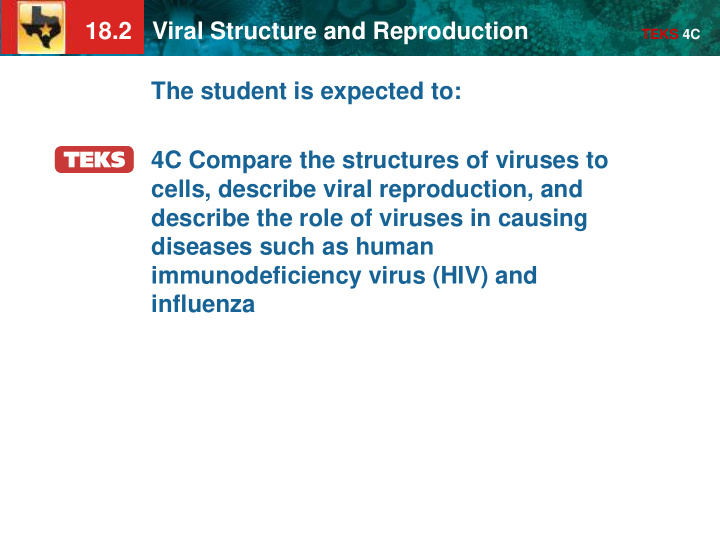



18.2 Viral Structure and Reproduction TEKS 4C The student is expected to: 4C Compare the structures of viruses to cells, describe viral reproduction, and describe the role of viruses in causing diseases such as human immunodeficiency virus (HIV) and influenza
18.2 Viral Structure and Reproduction TEKS 4C KEY CONCEPT Viruses exist in a variety of shapes and sizes.
18.2 Viral Structure and Reproduction TEKS 4C Viruses differ in shape and in ways of entering host cells. • Viruses have a simple structure. – genetic material – capsid, a protein shell – sometimes a lipid envelope, a protective outer coat enveloped helical polyhedral (influenza) (rabies) (foot-and-mouth disease) nucleic acid capsid surface capsid Surface proteins nucleic acid proteins lipid capsid envelope nucleic acid surface proteins lipid envelope
18.2 Viral Structure and Reproduction TEKS 4C • Viruses enter cells in various ways. – viruses of eukaryotes can enter by endocytosis – newly assembled viruses then exit via exocytosis, gaining their lipid envelope from the membrane of the host cell
18.2 Viral Structure and Reproduction TEKS 4C • Viruses enter cells in various ways. – viruses of eukaryotes can also fuse with the cell membrane – DNA (or RNA) are released into the cytoplasm of the host, while the viral envelope remains as part of the cellular membrane – newly assembled viruses then fuse with sections of h viral membrane in the host membrane to exit, or bud out
18.2 Viral Structure and Reproduction TEKS 4C • Bacteriophages are viruses that infect bacteria. capsid DNA tail sheath tail fiber
18.2 Viral Structure and Reproduction TEKS 4C • Viruses enter cells in various ways. – bacteriophages pierce host cells to inject their genetic material colored SEM; magnifications: large photo 25,000; inset 38,000x
18.2 Viral Structure and Reproduction TEKS 4C Viruses cause two types of infections. • A lytic infection causes the host cell to burst. host bacterium The bacterophage attaches and injects it DNA into a host bacterium. The host bacterium breaks apart, or lyses. Bacteriophages are able to infect new host cells. The viral DNA forms a circle. The viral DNA directs the host cell to produce new viral parts. The virus may enter the The parts assemble into new lysogenic cycle, in which the bacteriophages. host cell is not destroyed.
18.2 Viral Structure and Reproduction TEKS 4C • A lysogenic infection does no immediate harm. The prophage may leave the host ’ s DNA and enter the lytic cycle. The viral DNA is called a prophage when it combines with the host cell ’ s DNA. Although the prophage is not active, it replicates along with Many cell divisions produce a the host cell ’ s DNA. colony of bacteria infected with prophage.
18.2 Viral Structure and Reproduction TEKS 4C KEY CONCEPT Some viral diseases can be prevented with vaccines.
18.2 Viral Structure and Reproduction TEKS 4C Viruses cause many infectious diseases • There are many examples of viral infections. – common cold
18.2 Viral Structure and Reproduction TEKS 4C Viruses cause many infectious diseases • There are many examples of viral infections. – common cold – influenza
18.2 Viral Structure and Reproduction TEKS 4C Viruses cause many infectious diseases • There are many examples of viral infections. – common cold – influenza – SARS
18.2 Viral Structure and Reproduction TEKS 4C Viruses cause many infectious diseases • There are many examples of viral infections. – common cold – influenza – SARS – HIV • The body has natural defenses against many viruses. HIV-infected white blood cell
18.2 Viral Structure and Reproduction TEKS 4C Vaccines are made from weakened pathogens. • A vaccine stimulates the body ’ s own immune response. • Vaccines prepare the immune system for a future attack. • Vaccines are currently the only way to control the spread of viral disease.
18.2 Viral Structure and Reproduction TEKS 4C HIV Infection • HIV has RNA as its genetic material • Glycoproteins on the envelope cause human cells to allow it to enter • The HIV virus also has a copy of an enzyme called reverse transcriptase which is used to make a complementary DNA copy of the virus RNA • The complementary DNA is inserted into the cells genomic DNA, where it can lie dormant, sometimes for years • When activated, the viral DNA serves as a template for production of viral RNA, which is then used as a template for viral proteins
18.2 Viral Structure and Reproduction TEKS 4C Influenza Infection • the flu virus has eight RNA segments in a capsid, surrounded by an envelope studded with two types of glycoproteins, Hemaglutinin (H) and Neuraminidase (N) • the virus has a specific RNA polymerase which transcribes m-RNAs from each of the viral RNA’s • the H glycoproteins on the virus surface attaches to receptors on the host cell, allowing the virus to enter the host cell • N glycoproteins are thought to deform the membrane from inside allowing newly assembled viruses to leave the cell during virion budding • antibodies against flu are mainly directed against H and N, but these are different in different strains of flu, making vaccines hard to make
Recommend
More recommend